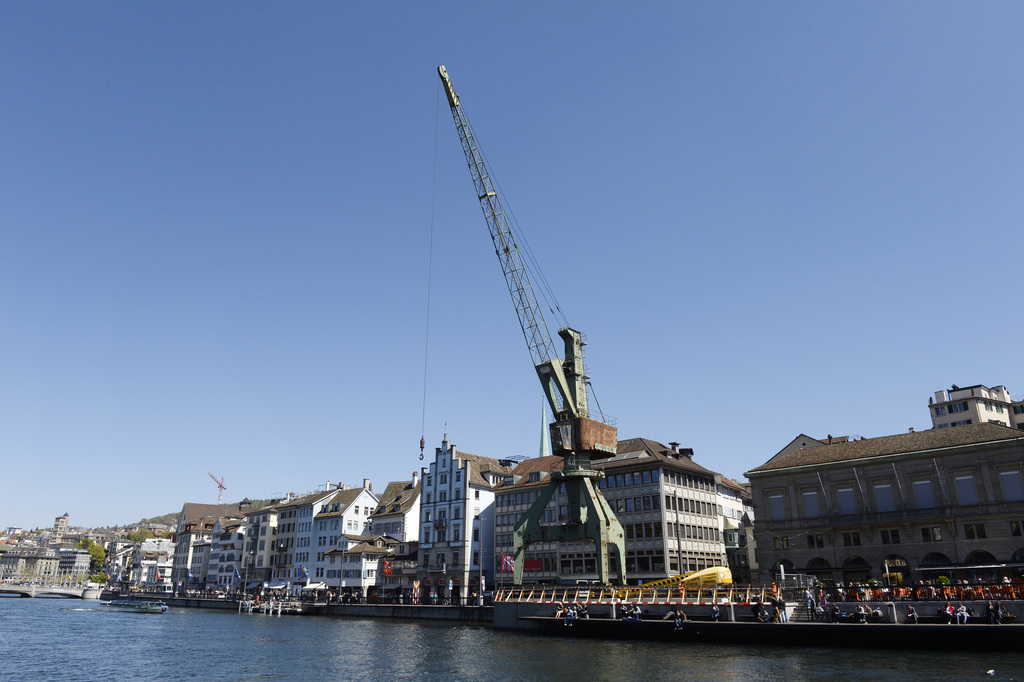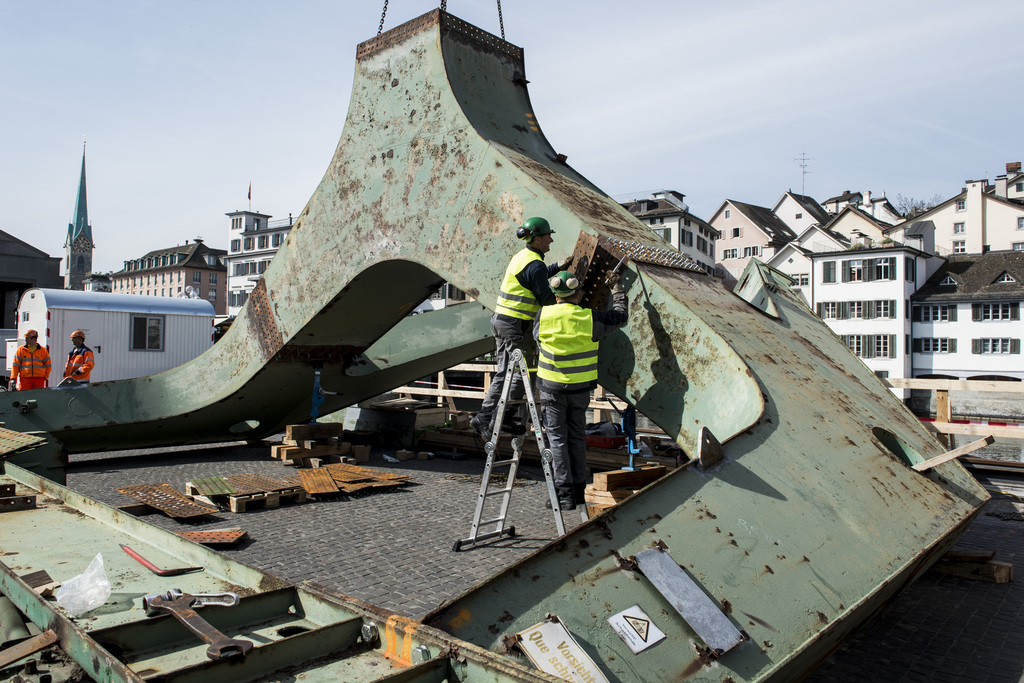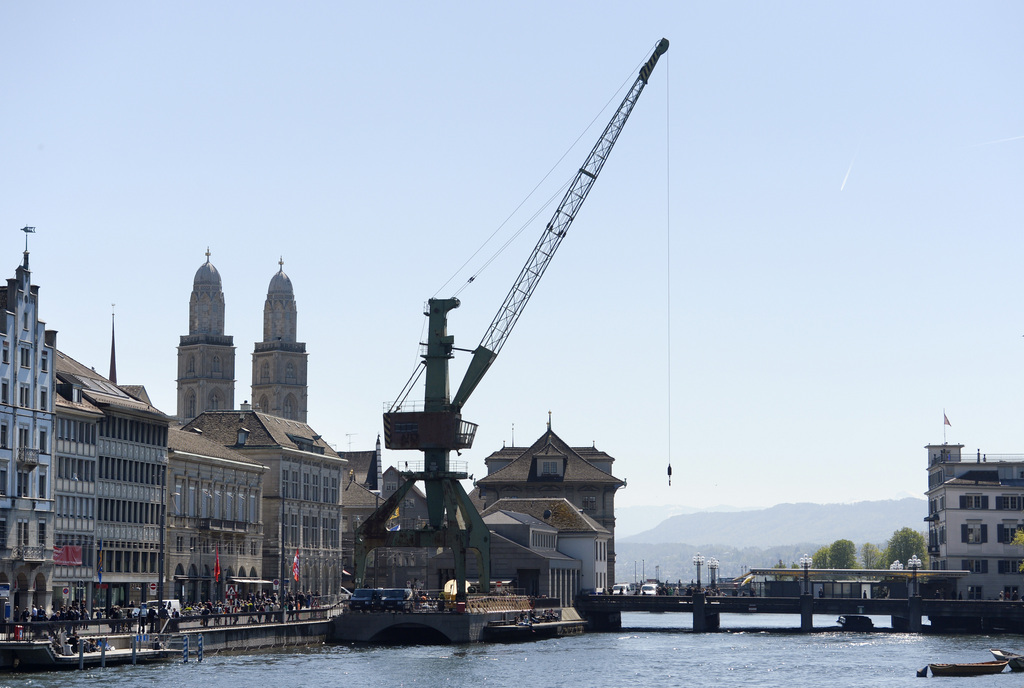Controversial crane causes heavy lifting

A 90-tonne rusting crane on the banks of the river Limmat has stirred up debate over what constitutes art in a public space. Some local politicians pushed through a vote on the issue, but even this use of direct democracy has come too late.
As a piece of work, the harbour crane is certainly eye-catching: 30 metres high and with a 36-metre long arm. Painted green, it is covered in patches of rust, testament to its almost 50 years of working life in the eastern German sea port of Rostock, over 1,000 kilometres away.
It arrived in Zurich at the beginning of April, having been saved from scrap, and was built up, piece by piece, by German workers. The total cost of the project: CHF600,000 ($682,000).
As the final pieces were being added, Zurich residents were out in force to have a look at the latest addition to the city skyline. An elderly man in a wheelchair and his wife have come out specially. “Back a bit,” the man says. “I want to take a photo.”
Elsewhere, camera phones are out in force, people blinking against the spring sun as they snap away. The artwork is also a talking point for people sitting outside in nearby cafés. Opinions range from “wow!” to “it’s a hulking pile of rust, thank goodness it’s only here for nine months!”
It has been controversial since its inception in 2009, with detractors objecting, among other things, to the cost to the taxpayer. The subject became a bit of a political and budgetary football, but in the end supporters of the artwork won out, not before the then head of the buildings department put in CHF80,000 of his own money when the project fell into financial trouble.
May 10 sees the official inauguration of the Zürich Transit Maritim project, before a “harbour festival” in July under the motto “the sea as a guest in Zurich”.

Art intervention
The driving force behind this “art intervention in public space” is artist and writer Jan Morgenthaler.
A total of 57 teams competed for the project, launched by the city authorities, to draw attention to the financial centre’s old heart. The aim was “to create discussion on how to create and manage the image of Zurich in a public space”, Morgenthaler explained.
The crane is meant to bring a feeling of the sea – and a sense of freedom – to landlocked Zurich, he said. The Rostock crane was found to be the most suitable, both in terms of reconstructing it in Zurich and aesthetically. But the exhibit is only temporary, he stressed.
“We are very happy that after nine months everything will go back to how it was before, so it’s only memories that we are creating.”
The crane is in fact the second part of a three-fold project: the first involved the installation of five bollards, then came the crane, and finally, on May 10, a large ocean ship’s horn will be sounded, and thereafter once a week until 2015.
Under Switzerland’s system of direct democracy, any member of the Swiss electorate can launch a people’s initiatives on a federal level to demand an amendment to the constitution. They can also be launched on a cantonal or communal level. These often have greater scope than a federal initiative. For example, in several cantons an initiative can be launched to request a law change.
The initiative “no to harbour cranes” – against the present crane and any future projects – is backed by the Zurich city People’s Party and the youth branch of the city’s centre-right Radical Party. There is no vote date yet.
Normally initiatives have a bigger scope (law or constitution), said Uwe Serdült, vice-director of the Centre for Research on Direct Democracy at the Centre for Democracy Studies Aarau. This initiative concerns an administrative (budgetary) decision that had already been decided.
But it does have a symbolic and preventative character, “that governments think twice before coming up with other projects which spend taxpayers money,” he told swissinfo.ch. Research has shown this. In general, those cities and cantons with more voting on finance issues generally fare better financially, i.e., have fewer deficits and budget issues.
(Source: www.ch.ch, Uwe Serdült)
ʽBlot on the cityscapeʼ
One of the project’s most vocal critics is the rightwing Swiss People’s Party’s local politician Roland Scheck.
“The crane is absurd. It was meant by the city government to show how cosmopolitan they are, to be a monument. It is not acceptable that an artwork becomes a blot on the cityscape,” he told swissinfo.ch.
He helped launch a people’s initiative, called “no to harbour cranes” to stop this or any project putting harbour infrastructure in the heart of Zurich.
It had gathered the required 6,000 signatures by December 2012. But no vote date has as yet been set.
“We would have been able to stop the current crane had the city government not dragged its feet, effectively ensuring that the vote would only happen after the project,” Scheck said.
The city government has officially rejected the initiative, saying that it did not correspond to the legal instruments for protecting the city centre. It pointed out that Zürich Transit Maritim had already been granted permission and couldn’t be stopped retrospectively.
Morgenthaler expected that his crane would not be loved by everyone – but he admits to being a bit surprised at the vehemence of the reactions. “It is a very emotional thing. Many people were against it but nevertheless they are now coming to see it.”
Das Nagelhaus, Zurich, 2010 – this project, inspired by a Chinese house owner in Chongqing who refused to move out to make way for a shopping centre, was voted down. It would have cost CHF6 million, making it one of the most expensive in a public space.
Der Rote Platz, St Gallen, 2005 – a huge alfresco permanent “city lounge” in the heart of the financial district by Swiss artist Pipilotti Rist and architect Carlos Martinez. The colour was topped up two years ago.
Intersection, Basel, 1994 – a large metal sculpture by American sculptor Richard Serra, which now stands in the Theaterplatz after it was purchased by a privately formed committee. Still comes in for criticism as it is used for graffiti.
Oppenheim Tower Fountain, Bern, 1983 – created by artist Meret Oppenheim, symbolising growth and life. It is an 8-metre-high concrete column, down which water flows in a spiral. Overgrown and subject to limescale, which makes some want to clean it up. Others think it should be left alone. Bern recently took a middle road: cleaning some areas and shoring it up.
(source: swissinfo.ch, Swiss public television and radio)
Mixed views
Not all art experts are totally convinced either. “I consider it a rather mediocre work of art which illustrates basically a nice idea but which does not go much further than this idea,” Philip Ursprung, professor of the History of Art and Architecture at the Federal Institute of Technology in Zurich, told swissinfo.ch.
The controversy has arisen from the fact that the project has been “instrumentalised on a political level for quite a while”, he said.
A further reason is that the crane is quite different from most traditional works of art. “But there have been discussions about almost every public work of art in the past 30-40 years,” Ursprung said. “It becomes almost an automatism that if such issues are at stake, public opinion is activated.” It would be the same in Vienna or Manchester, he argued.
So even if the artwork has created perhaps more attention that it deserves, Ursprung said, “on the other hand, it is, in some sense, a good sign if people discuss about art in the public realm and care about the public space”.

In compliance with the JTI standards
More: SWI swissinfo.ch certified by the Journalism Trust Initiative


You can find an overview of ongoing debates with our journalists here. Please join us!
If you want to start a conversation about a topic raised in this article or want to report factual errors, email us at english@swissinfo.ch.